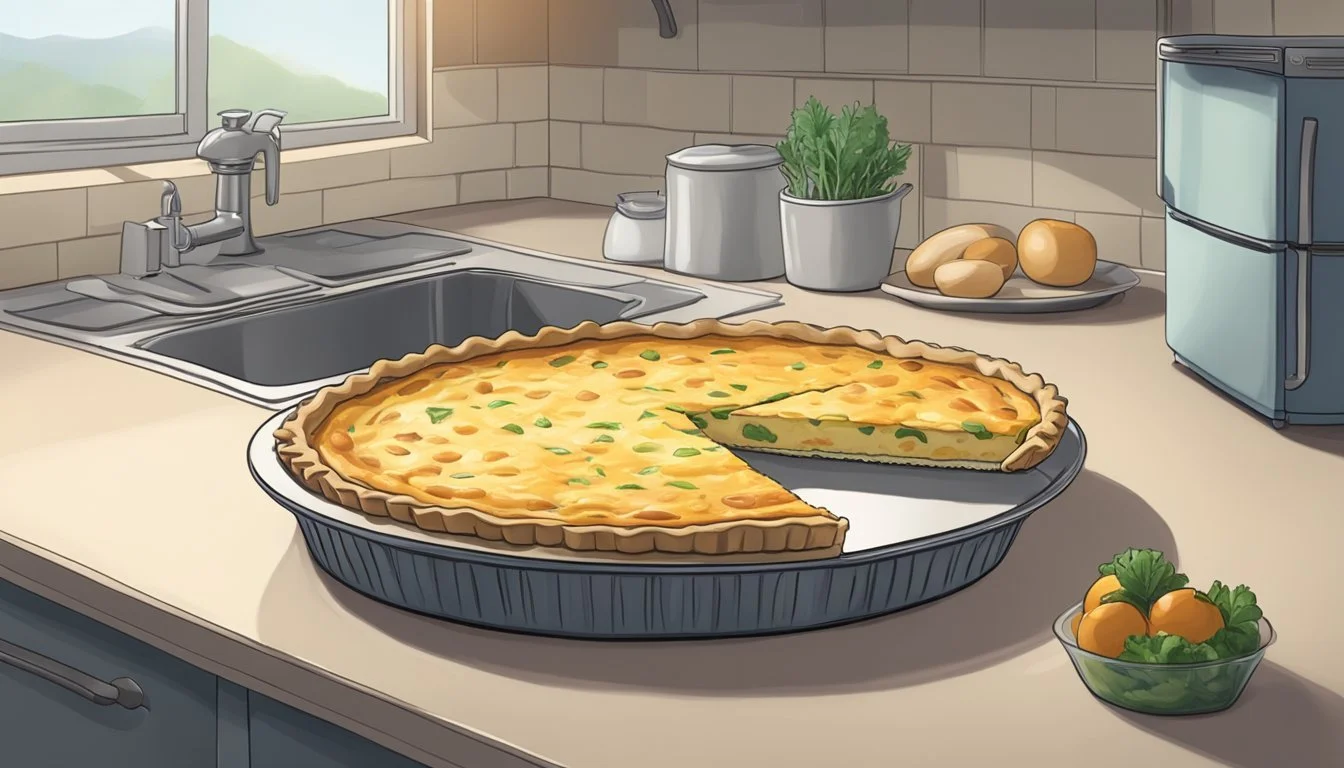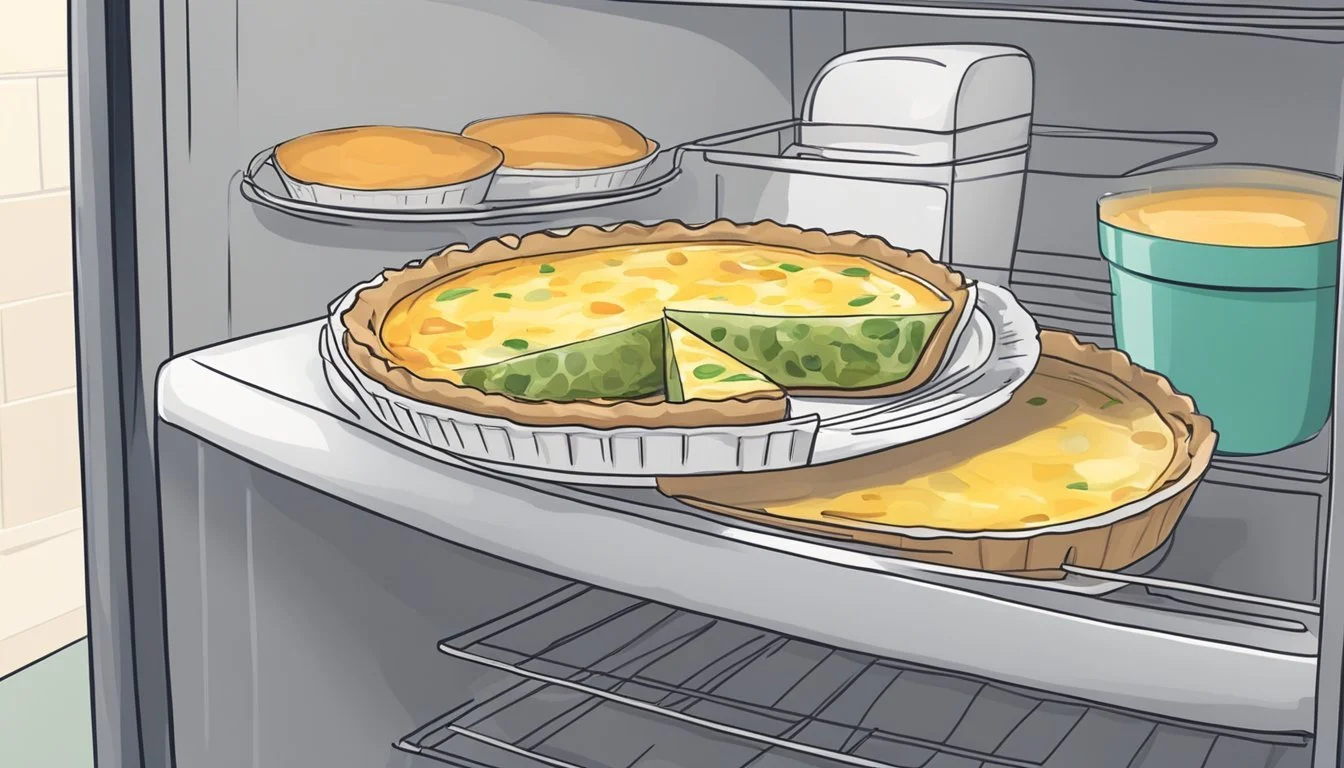Do I Have to Refrigerate Quiche?
Understanding Safe Storage Practices
When it comes to storing quiche, refrigeration is essential to maintain its freshness and prevent the growth of bacteria. Quiche, a savory egg-based custard pie often filled with cheese, meat, seafood, or vegetables, is not only an elegant dish but also a perishable one. After baking, any leftovers should be stored in the refrigerator. It is best enjoyed within three to four days when kept at a consistent cold temperature. This ensures the quiche remains safe to eat and retains its flavor and texture.
Refrigerating quiche promptly preserves its quality. The dense, creamy texture of quiche is susceptible to the proliferation of bacteria if left at room temperature for prolonged periods. Bacterial growth can lead to spoilage and foodborne illnesses, so it's advisable to refrigerate the quiche within two hours of cooking. To optimize its shelf life and taste, covering the quiche with aluminum foil or plastic wrap can prevent it from absorbing other flavors in the refrigerator.
When the moment arrives to reheat quiche, it should be done thoroughly to achieve the ideal warmth throughout. Preheating the oven and warming the quiche at the recommended temperature carefully restores its appetizing warmth without overcooking the edges or drying out the custard. Covering the crust edges with foil can further aid in even reheating, allowing the quiche to regain its freshly baked appeal.
Understanding Quiche
Quiche is a versatile dish that combines a savory custard filling with a flaky pastry crust. This section delves into the key components of a quiche and the various types that can be created.
Quiche Essentials
At the heart of any quiche, there are a few essential ingredients: eggs, milk or cream, and a pastry crust. These elements form the base for any variation of quiche.
Eggs and Dairy: For the custard, a mixture of eggs, milk, and/or cream is whipped together. The ideal ratio ensures the quiche is creamy without being rubbery.
Crust: The quiche is held together by a crust, typically made from shortcrust pastry. This should be blind-baked to avoid sogginess from the custard.
Cheese: Often, cheese is added for flavor and texture. Popular choices include cheddar, Gruyère, and Swiss.
Filling: Various meats (commonly bacon), vegetables, or seafood can be mixed in, making quiche a dish that can be easily adapted to personal taste or dietary requirements.
Varieties of Quiche
There is a wide range of quiche varieties, each with its unique flair and ingredients. Some of the most well-known include:
Quiche Lorraine: Originating from the Lorraine region in France, it features bacon and cheese.
Vegetarian Quiche: Filled with a mixture of vegetables such as spinach, mushrooms, and onions.
Seafood Quiche: Incorporates seafood like shrimp or salmon for a luxurious twist.
The diversity of quiche gives it the flexibility to be a satisfying meal for breakfast, lunch, or dinner, proving its place as a cherished dish in many cuisines.
Proper Storage Techniques
Proper storage of quiche is crucial to maintain its freshness and flavor. Below are the techniques one should employ to store fresh quiche, preserve leftovers, and manage freezing and thawing.
Storing Fresh Quiche
After baking, a quiche needs to cool to room temperature before refrigeration. One should refrigerate fresh quiche within two hours of baking to prevent foodborne illness. Wrapping the quiche in plastic wrap or aluminum foil can protect it from absorbing other flavors in the fridge and also prevent it from drying out. It’s best to store it in an airtight container to further ensure freshness.
Refrigerate: Within 2 hours of baking
Temperature: Keep the fridge between 34°F and 40°F (1°C and 4°C)
Wrapping: Use plastic wrap or aluminum foil
Container: Optional airtight container for added protection
Preserving Leftover Quiche
Leftover quiche should be handled similarly to fresh quiche. Ensure the leftovers are wrapped tightly to create a seal against air. An airtight container is again recommended for the best results in preserving the quality of the quiche. Leftovers should be stored in the refrigerator and typically last for 3-4 days when properly sealed.
Wrapping: Tightly with plastic wrap or aluminum foil
Refrigerate: Store leftovers within 2 hours of serving
Shelf Life: Approximately 3-4 days
Freezing and Thawing Quiche
For long-term storage, quiche can be frozen. Before freezing, wrap it in multiple layers of plastic wrap or aluminum foil, then place it inside a freezer bag or airtight container. Properly wrapped and stored, quiche can last in the freezer for up to three months. When ready to eat, thaw in the refrigerator overnight before reheating. Avoid defrosting quiche in the microwave as it can lead to uneven heating and affect the texture.
Freezing: Wrap in layers, use freezer bag or airtight container
Shelf Life in Freezer: Up to 3 months
Thawing: Overnight in the fridge; avoid microwave
Food Safety Considerations
When storing quiche, adherence to food safety practices is paramount to prevent foodborne illnesses. Keeping quiche refrigerated ensures its freshness and extends its shelf life, while also avoiding the risks associated with dairy products at room temperature.
Temperature Control
To maintain food safety, quiche should be stored at a temperature below 40°F (4°C). Refrigeration is necessary because quiche typically contains dairy products that are prone to bacterial growth at higher temperatures. Freshly baked quiche must be allowed to cool to avoid condensation, but should not sit out on the counter longer than 2 hours, as per USDA guidelines. Freezing is an alternative that can keep quiche safe for up to three months.
Refrigerate: Keep below 40°F (4°C).
Cooling Time: Maximum 2 hours on the counter.
Freezing: Safe for up to 3 months.
Identifying Spoiled Quiche
Determining if a quiche has spoiled is critical to food safety. Some indicators of a spoiled quiche include an off smell, visible mold, and a texture change in the filling or crust. If any signs of spoilage are present, it should not be consumed as it could lead to food poisoning. Regular checks for freshness are important, especially if the quiche has been stored for a few days.
Smell: Off or sour odor.
Visual Cues: Mold or discoloration.
Texture: Soggy crust or altered filling consistency.
Serving and Presentation
When serving quiche, whether it's for breakfast, brunch, lunch, a light dinner, or at a party, maintaining its delicious taste and appealing presentation is paramount. The right reheating method ensures the quiche is enjoyed as intended, while the presentation on the table should be inviting and complement the meal.
Reheating Quiche
To enjoy a quiche at its best, careful reheating is essential, especially to preserve its texture and flavor:
Oven Instructions:
Preheat your oven to 350°F (175°C).
Place the quiche on a baking sheet.
For a refrigerated quiche, heat it for 15-20 minutes.
If the quiche was frozen but has been thawed, 25-30 minutes is ideal.
Cover with foil to prevent excess browning.
Microwave Instructions (not ideal for even heating):
Heat a slice of quiche on medium power for 1-2 minutes.
Rotate or stir if possible halfway through.
The quiche should reach an internal temperature of 165°F when properly reheated.
Serving Suggestions
Presentation is an integral part of serving quiche:
Plating:
Plate the quiche on an attractive serving dish.
Alternatively, serve individual slices directly to guests.
Garnishing:
Enhance the dish with fresh herbs like chopped parsley or chives for color.
Consider a side of salad or fresh fruits to complement the quiche.
By following these serving and presentation guidelines, one can ensure that their meal not only tastes great but also makes a wonderful impression on any table or at any event.
Recipe and Preparation Tips
Achieving the perfect quiche involves attention to the crust, a balanced ratio of ingredients, and the right cooking techniques. Proper handling and preparation ensure the quiche's flavor and texture are exceptional.
Creating the Perfect Crust
To create a flaky and buttery crust, one must incorporate cold butter into the flour mixture until pea-sized crumbs form. Rolling out the dough after chilling for at least one hour enhances the crust's texture. A well-executed crust acts as the foundation for the quiche, supporting the delicate custard filling.
Ingredients for crust:
1 1/4 cups all-purpose flour
1/2 tsp salt
1/2 cup butter, chilled and diced
4-5 tbsp ice water
Balancing Ingredients
A quiche's custard filling depends on a delicate balance of eggs and dairy. The ideal ratio for a velvety texture typically combines one part egg to two parts dairy. Full-fat dairy such as whole milk or cream contributes to the richness of the custard. For a vegetarian quiche, one can select fillings like sautéed vegetables, cheese, and herbs.
Custard base ratio:
Eggs: 3 large
Dairy (whole milk or cream): 1 1/2 cups
Salt: 3/4 tsp
Black pepper: 1/4 tsp
Cooking Techniques
Cook the quiche at a lower temperature, around 350°F (177°C), to prevent the eggs from scrambling and to achieve a creamy consistency. Blind baking the pie crust before adding the filling prevents sogginess. The quiche should be baked until it's just set and still slightly wobbly in the center.
Cooking steps:
Blind bake the crust at 425°F for 8 minutes.
Lower the oven temperature to 350°F.
Add fillings to the pre-baked crust.
Pour the egg and dairy mixture over the fillings.
Bake for 35-45 minutes, or until set.
Common Questions Answered
When it comes to quiche, proper storage is crucial for maintaining its freshness and ensuring food safety. This section addresses frequently asked questions ranging from refrigeration and freezing of quiche to reheating techniques.
Refrigeration Queries
Q: Is refrigeration necessary for quiche?
A: Yes. It's essential to refrigerate quiche to retain its freshness and prevent bacterial growth. A quiche will typically last for three to four days when stored in the fridge.
Q: How should leftover quiche be stored in the refrigerator?
A: Leftover quiche should be placed in an airtight container or wrapped tightly with plastic wrap or aluminum foil to prevent it from absorbing odors and to maintain moisture.
Freezing Concerns
Q: Can quiche be frozen for longer storage?
A: Quiche can be stored in the freezer to extend its shelf life up to three months. Ensure it is wrapped securely to prevent freezer burn.
Q: What is the proper method for thawing frozen quiche
A: To thaw frozen quiche, transfer it from the freezer to the refrigerator and allow it to thaw overnight. Avoid thawing at room temperature to minimize the risk of bacterial growth.
Reheating Methods
Q: What is the most recommended way to reheat quiche?
A: Reheating quiche in the oven is ideal. Preheat the oven to 350°F (175°C), place the quiche on a baking sheet, cover it with foil, and heat for about 20-30 minutes.
Q: Is microwave reheating suitable for quiche?
A: For quick reheating, individual slices of quiche can be warmed up in a microwave for approximately 1-2 minutes. Be mindful that microwaving can lead to uneven heating and a less crispy crust.






